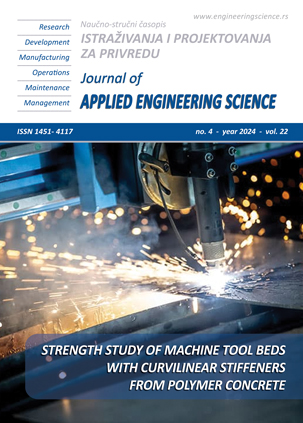INNOVATIVE AIRSHIP DESIGN FOR REAL-TIME AIR QUALITY MONITORING USING IOT TECHNOLOGY
Abstract
The effect of poor air quality on human health has been linked to both short-term and long-term exposure to air pollutants. One of the most important steps in reducing emissions is accurate identification of these pollutants. This can be achieved by using Internet of Things equipped remotely operated airships that can survey large areas and gather pollution data. The ability of an airship to function at low altitudes for extended periods is the main design requirement of airships. This study describes a methodology for conceptualizing and building a helium-filled blimp for remote measurement of atmospheric pollutants (Carbon monoxide, Carbon dioxide, and Sulphur dioxide), temperature, and pressure. An onboard telemetry system measures the data while the airship is in flight and transmits them in real time to a ground-based station. The experiment showed that remotely operated airships are capable of gathering air data and their quality, enabling environmental scientists and regulatory agencies to better understand the behaviour of air pollutants and take steps to mitigate them.
References
Tillmann, R., Gkatzelis, G.I., Rohrer, F., Winter, B., Wesolek, C., Schuldt, T., Lange, A.C., Franke, P., Friese, E., Decker, M., Wegener, R. (2022). Air quality observations onboard commercial and targeted Zeppelin flights in Germany–a platform for high-resolution trace-gas and aerosol measurements within the planetary boundary layer. Atmospheric Measurement Techniques, vol. 15, no.12, 3827-3842, DOI: 10.5194/amt-15-3827-2022
Manikandan, M., Pant, R. S. (2021). Research and advancements in hybrid airships-A review. Progress in Aerospace Sciences, vol. 127, 100741, DOI: 10.1016/j.paerosci.2021.100741
Liao, L., Pasternak, I. (2009). A review of airship structural research and development. Progress in Aerospace Sciences, vol. 45, no.4-5, 83-96, DOI: 10.1016/j.paerosci.2009.03.001
Dorrington, G. E. (2006). Drag of spheroid-cone shaped airship. Journal of aircraft, vol. 43, no.2, 363-371, DOI: 10.2514/1.14796
Gangadhar, A., Manikandan, M., Rajaram, D., Mavris, D. (2021). Conceptual design and feasibility study of winged hybrid airship. Aerospace, vol. 9, no.1, 8, DOI:10.3390/aerospace9010008
Mang. C., Yiping, L. (2017). Flat type airship. Patent for the invention CN 205931210 U, 08.02.2017. Application no. 201620742910 dated 14.07.2016.
Bock, J. K., Künkler, H. (2015). Concept of a Lenticular Hybrid Airship Using Hydrogen for Multiple Operation Modes. 10th International Airship Convention 2015, p 1-6.
Fazakas, Gabor. (2000). Hybrid Toroidal Airship. Patent published for the invention WO 2000032469 A1, 08.06.2000.
Suefuku, H., Hirayama, T., Hirakawa, Y., Takayama, T. (2010). Torus-type airship aiming at high airworthiness quality. 27th international congress of the aeronautical sciences 2010, p. 1-10.
Powell, J., Folsom, C.A. (2011). High altitude two balloon airship. Patent for the invention US 8061647 B1, 22.11.2011. Application no. 12/082420 dated 10.04.2008.
Manikandan, M., Shah, R. R., Priyan, P., Singh, B., Pant, R. S. (2024). A parametric design approach for multi-lobed hybrid airships. The Aeronautical Journal, vol. 128,1-36, DOI: 10.1017/aer.2023.37
Pope, C. (2004) “The big lift,” Professional Engineering, vol. 17, no. 8, 24-25.
Sighard Hoerner, F. (1965). Fluid-dynamic Drag. Hoerner Fluid Dynamics, Bakersfield, CA 93390
Pant, R. S. (2008). Methodology for determination of baseline specifications of a nonrigid airship. Journal of Aircraft, vol. 45, no.6, 2177-2182. DOI: 10.2514/1.34858
Sonawane, B. S., Fernandes, M. A., Pant, V., Tandale, M. S., Pant, R. S. (2014). Material characterization of envelope fabrics for lighter-than-air systems. International Colloquium on Materials, Manufacturing and Metrology 2014.
Shaikh, A., Inamdar, J. A., Saleem., Sayyed Mufeed Fidae. (2015). Design and development of indoor airship; gondola (fixed and sliding), avionics, nose batten. Thesis, School of Engineering and Technology, Anjuman-I-Islam’s Kalsekar Technical Campus, New Panvel.
Gawale, A.C., Raina, A.A., Pant, R.S., Jahagirdar, Y.P. (2008). Design, Fabrication and Operation of Remotely Controlled Airhips in India. 26th international congress of the aeronautical sciences 2008, p. 1-12.

